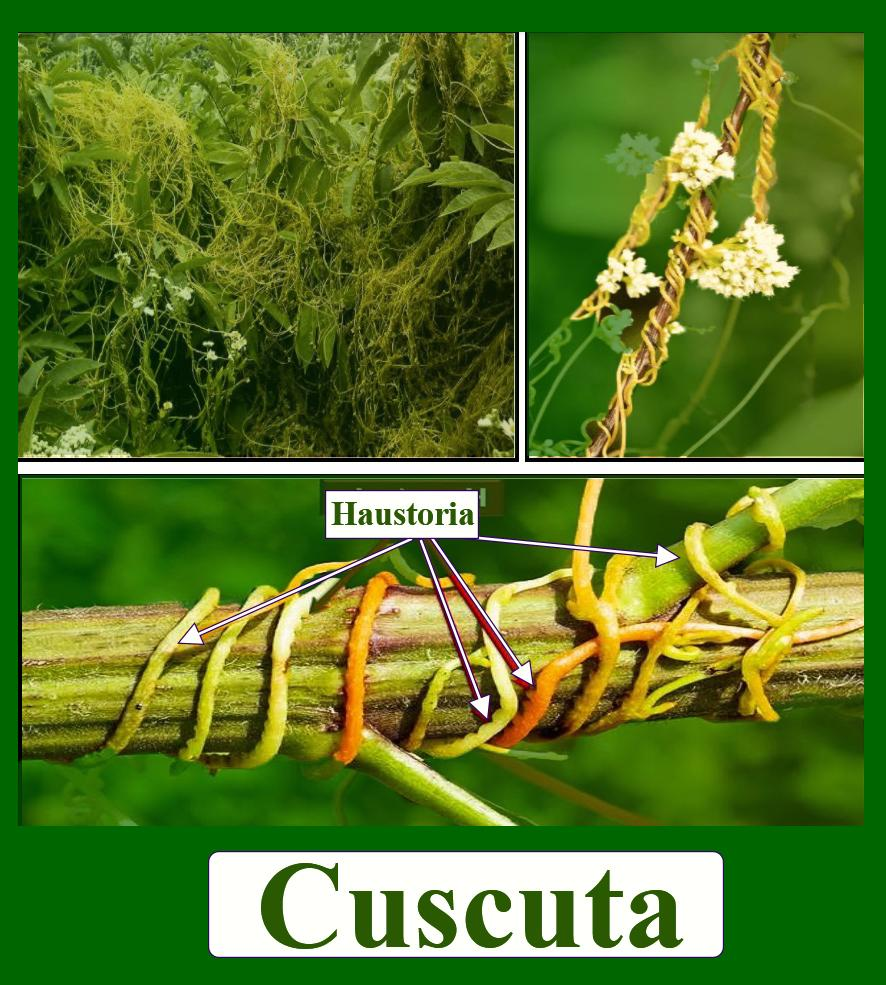
Haustoria or sucking roots occurs in
(a) Betel
(b) Orchid
(c) Cuscuta
(d) Tinospora
Answer
466.5k+ views
Hint: In this plant, the process of photosynthesis does not take place, so they get their nutrition through sucking roots from the other plant on which they survive.
Complete answer:
Haustoria or sucking roots occur in Cuscuta. Cuscuta bears non-green stems and scale leaves. They have no connection with the soil. Haustorial roots are also called sucking roots and are found especially in parasitic plants. These roots penetrate the host tissue for the absorption of nutrients and they are small in size.
The parasitic plant fixes its root with the surface of the host plant and makes a connection with both the xylem and the phloem of the host plant for the absorption of water and food for their nutrition.
For example, the Viscum album and Cuscuta.
Additional Information: -Betel is also known as pan. These plants bear two types of root system:
Taproot system - taproots are very thick and straight tapering in shape growing directly downwards. E.g., radish and carrot
Adventitious root systems - these roots develop from an organ such as rhizomes, corms, and tubers. other than the root. E.g., Ivy, Horsetails, Oak trees, and Cypress.
-Orchid plants bear tuberous roots. Some more examples of tuberous roots are the sweet potato, cassava, and dahlia.
-Tinospora also bears adventitious roots.
So, the correct answer is “Cuscuta.”
Note: -All major divisions of Fungi also form haustoria.
-Generally, when penetrating, the fungus increases the surface area in contact with the host plasma membrane and releases enzymes that break up the cell walls.
-This enables the greater potential movement of organic carbon from host to fungus.
-An insect hosting a parasitic fungus if we may look though it seems"eaten from the inside out" because the haustoria expands inside of it.e.g, cordyceps.

Complete answer:
Haustoria or sucking roots occur in Cuscuta. Cuscuta bears non-green stems and scale leaves. They have no connection with the soil. Haustorial roots are also called sucking roots and are found especially in parasitic plants. These roots penetrate the host tissue for the absorption of nutrients and they are small in size.
The parasitic plant fixes its root with the surface of the host plant and makes a connection with both the xylem and the phloem of the host plant for the absorption of water and food for their nutrition.
For example, the Viscum album and Cuscuta.
Additional Information: -Betel is also known as pan. These plants bear two types of root system:
Taproot system - taproots are very thick and straight tapering in shape growing directly downwards. E.g., radish and carrot
Adventitious root systems - these roots develop from an organ such as rhizomes, corms, and tubers. other than the root. E.g., Ivy, Horsetails, Oak trees, and Cypress.
-Orchid plants bear tuberous roots. Some more examples of tuberous roots are the sweet potato, cassava, and dahlia.
-Tinospora also bears adventitious roots.
So, the correct answer is “Cuscuta.”
Note: -All major divisions of Fungi also form haustoria.
-Generally, when penetrating, the fungus increases the surface area in contact with the host plasma membrane and releases enzymes that break up the cell walls.
-This enables the greater potential movement of organic carbon from host to fungus.
-An insect hosting a parasitic fungus if we may look though it seems"eaten from the inside out" because the haustoria expands inside of it.e.g, cordyceps.

Recently Updated Pages
The correct geometry and hybridization for XeF4 are class 11 chemistry CBSE

Water softening by Clarks process uses ACalcium bicarbonate class 11 chemistry CBSE

With reference to graphite and diamond which of the class 11 chemistry CBSE

A certain household has consumed 250 units of energy class 11 physics CBSE

The lightest metal known is A beryllium B lithium C class 11 chemistry CBSE

What is the formula mass of the iodine molecule class 11 chemistry CBSE

Trending doubts
State the laws of reflection of light

One Metric ton is equal to kg A 10000 B 1000 C 100 class 11 physics CBSE

What is the modal class for the following table given class 11 maths CBSE

Give an example of a solid solution in which the solute class 11 chemistry CBSE

Describe the effects of the Second World War class 11 social science CBSE

Which of the following methods is suitable for preventing class 11 chemistry CBSE




